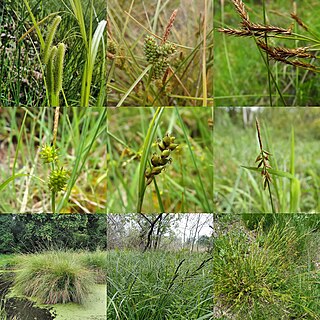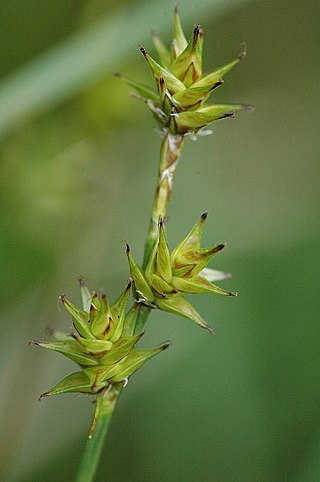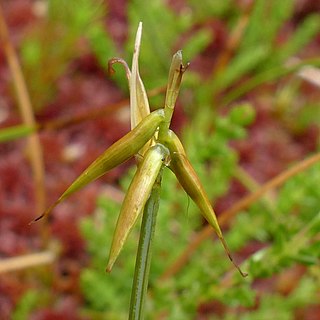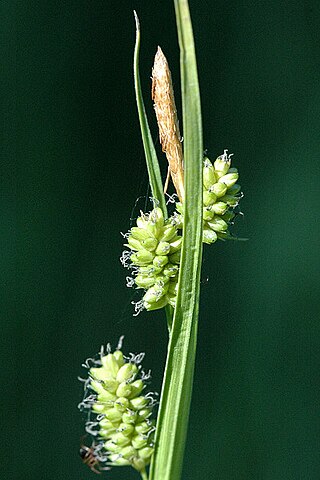
Elba is a Mediterranean island in Tuscany, Italy, 10 km (6.2 mi) from the coastal town of Piombino on the Italian mainland, and the largest island of the Tuscan Archipelago. It is also part of the Arcipelago Toscano National Park, and the third largest island in Italy, after Sicily and Sardinia. It is located in the Tyrrhenian Sea about 50 km (30 mi) east of the French island of Corsica.

The Tyrrhenian Sea is part of the Mediterranean Sea off the western coast of Italy. It is named for the Tyrrhenian people identified with the Etruscans of Italy.

The Cyperaceae are a family of graminoid (grass-like), monocotyledonous flowering plants known as sedges. The family is large; botanists have described some 5,500 known species in about 90 genera – the largest being the "true sedges", with over 2,000 species.

The Tuscan Archipelago is a chain of islands between the Ligurian Sea and Tyrrhenian Sea, west of Tuscany, Italy.

Carex is a vast genus of over 2,000 species of grass-like plants in the family Cyperaceae, commonly known as sedges. Other members of the family Cyperaceae are also called sedges, however those of genus Carex may be called true sedges, and it is the most species-rich genus in the family. The study of Carex is known as caricology.

Carex echinata is a species of sedge known by the common names star sedge and little prickly sedge.

Carex nigra is a perennial species of plant in the sedge family Cyperaceae. Common names include: smooth black sedge,black sedge and common sedge.

Carex pauciflora, the few-flowered sedge, is a perennial species of sedge in the family Cyperaceae native to bogs and fens in cool temperate, subarctic, and mountainous regions of the Northern Hemisphere. The specific epithet pauciflora refers to the Latin term for 'few flowered'.
Georg Kükenthal was a German pastor and botanist who specialized in the field of caricology. He was the brother of zoologist Willy Kükenthal (1861–1922).

Carex sect. Spirostachyae is a section of the genus Carex, containing 38 species of sedge. Species in Carex sect. Spirostachyae share a suite of features, including the short internodes of the primary rhizomes, the presence of an antiligule, the leaf-like, sheathing bract at the base of the inflorescence, the presence of three stigmas in female flowers, and the shape of the seeds.
Carex acaulis, known as the small dusky sedge, is a species of sedge in the genus Carex native to the Falkland Islands and southern Argentina.

Carex subg. Vignea is a subgenus of the sedge genus Carex, containing around 300 of the 2000 species in the genus. Its members are characterised by having bisexual, sessile spikes, where the female flowers have two stigmas each.
Carex accrescens is a species of sedge that was first described by Jisaburo Ohwi in 1931. It is native to eastern Asia, from Siberia to the Korean Peninsula and Japan.
Peter William Ball is an English-born botanist, plant collector, and plant taxonomist, specializing in caricology.

Carex flava, called hedgehog grass or large yellow sedge, is a widespread species of sedge, native to the northern United States, Canada, Iceland, Europe, the Atlas Mountains in Africa, the Transcaucasus area, and parts of Siberia. It is a synonym of the Carex flava species complex.

Carex demissa is a species of sedge, native to Iceland, Macaronesia, all of Europe, and western Asia to the Himalayas and possibly Greenland. It has been introduced to eastern Canada, New Jersey, and Tasmania. It is a member of the Carex flava species complex.

Carex lepidocarpa, called the long-stalked yellow-sedge, is a species of flowering plant in the genus Carex, native to eastern Canada, Morocco, and most of Europe. It is a member of the Carex flava species complex.

Schoenus inconspicuus is a species of sedge endemic to south-western areas of the Western Cape Province of South Africa.
Carex tsoi is a species of sedge in the family Cyperaceae, native to Hainan, China. It was formerly thought to be in section Radicales.
Carex ledongensis is a species of sedge in the family Cyperaceae. Found in the tropical monsoon rainforests of Hainan Island, China, it was described as a new species in 2020. It shares similarities with the species Carex pseudotristachya but exhibits distinct characteristics that set it apart.













